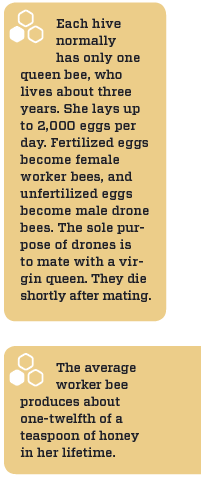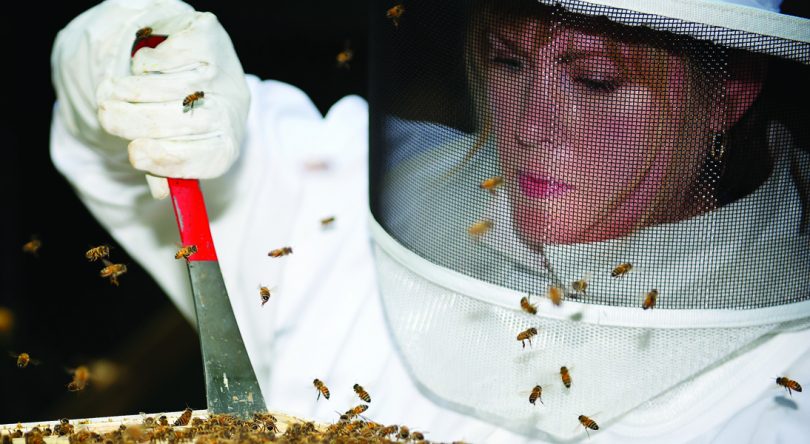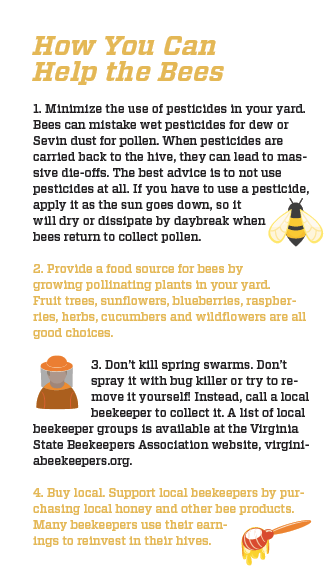Written By Donna C. Gregory
Photos by Ed Ip
—
Don’t let their tiny size fool you. Each day, billions of honeybees perform the big job of pollinating the agricultural crops that end up on our dining room tables.
According to the U.S. Department of Agriculture, the pollination efforts of the nation’s honeybees are valued at $15 billion. The shiny, red apple in your child’s lunch, the cucumber sliced up in your salad and the pack of sunflower seeds you munched on for a snack are all made possible because of the many honeybees skipping across farmers’ fields.
“Every third bite of food is somehow related to honeybee pollination,” says Sean Kenny, vice president of the Norfolk Beekeepers Association. “The diet we’ve evolved to in this country is highly linked to honeybee pollination.”
Unfortunately, honeybees are facing both natural and manmade threats. In Virginia, about one-third of honeybee hives die off each year. Nationally, the number is up to 40 percent, says Kenny.
 If honeybee populations continue to decline, it could have a very real impact on the foods that make it onto grocery store shelves.
If honeybee populations continue to decline, it could have a very real impact on the foods that make it onto grocery store shelves.
“We won’t have food as we know it,” Kenny says. “We won’t have the apples, we won’t have the melons, we won’t have the squashes. We’ll have lots of wheat, and we’ll have lots of corn. A lot of things we’ve depended on for daily sustenance won’t be present.”
Mighty mites
The single biggest threat to honeybees is the parasitic varroa mite. It attacks on two fronts: by feeding on the blood of the bees within the hive and by weakening the hive as a whole, making it more susceptible to viruses and other parasites. Varroa mites are the top reason hives die off each year.
Colony collapse disorder (CCD) is another threat, and is mostly found in the commercial beekeeping industry.
“You go into a colony, and there’s thirty, forty, fifty thousand insects, and the next day, there’s just a fraction of that,” describes Pete Ostrowski, a Gloucester County beekeeper. “There’s just the queen and some attendant bees. Most of the adult workforce is gone, and they don’t know why.”
A study published in January in the American Chemical Society’s Environmental Science & Technology journal speculates that CCD may be caused by neonicotinoid insecticides that are widely used on agricultural crops.
“There are lots of theories out there, but no definite proof that we know what it is,” Kenny says.
Bringing back the bees
To help offset of loss of colonies each year, local beekeeping groups, like the Tidewater and Colonial beekeepers associations hold training programs to encourage new beekeepers. The Tidewater group held a seminar in January. Fifty participants had the opportunity to take part in Tidewater’s “Bee Yard Sweat Equity” program, in which aspiring beekeepers train alongside experienced beekeepers in learning how to care for hives. Graduates receive a beehive of their own at the conclusion of the training.
There also are efforts to educate the general public on the plight of the honeybee and its importance to the environment. Frank Walker, president of the Virginia State Beekeepers Association, has made it his mission to teach the public what to do if they encounter a swarm of bees.
Each spring, healthy colonies instinctually swarm, meaning the queen and about half of the colony will leave the hive to start a new colony. They cluster on a tree, fence, mailbox or other structure as they wait for scout bees to find a new home.
Many scared homeowners’ first
reaction is to grab a can of insect killer and start spraying. Beekeepers heartily say, “Don’t!”
“The unfortunate fact [is] the bees they killed were those bees that had the right genetic makeup to swarm in the spring,” says Kenny. “They were strong enough to survive the winter, and they are the bees we want because they show some resistance to the varroa mite. Losing them to a panicked homeowner is tragic.”
Walker regularly speaks to civic groups and distributes fliers, asking the public to call a local beekeeping group if they see a swarm. Most groups have members who will come out and collect the swarm for free. Those swarms are then given to other beekeepers to manage.
Staying b-u-z-z-y
After watching his father-in-law work with bees, Paul Hodge became fascinated with the intricacies of life in the beehive. During the summer, a hive can grow to more than 60,000 bees. Female worker bees take on a series of roles during their lifetime, moving from housekeeper to construction worker, grocer, undertaker, guard, and finally, becoming foragers. Foragers collect the nectar and pollen for the hive and are the only bees most people ever see.
“You realize that there’s a sense of order in [the hive],” says Hodge, president of the Ashland Beekeepers Association. “The bees that are out there gathering nectar today are only going to live another four weeks, and then they’re going to be dead. To me, it’s amazing that these bees are working so hard to produce honey for three or four generations from them.”
Hodge currently works about 11 hives at or near his Ashland home. His duties change with the seasons. His “year” typically begins in August or September, when the last of the honey has been harvested. Beekeepers have to be careful to leave enough honey for the hive to feed on over the long winter. The typical hive requires about 60 pounds.
In the fall, Hodge treats his hives for varroa mites using natural methods and feeds them sugar water if more honey is needed for overwintering. Each hive instinctually forces out male drone bees to reduce its size in preparation for the cold months ahead.

When the outside temperatures drop, the remaining bees form a mass around the queen and generate heat by flexing their muscles.
The strength and viability of the queen is key to the future of the hive. “If the queen will not live through the winter, the hive will not survive,” says Hodge.
Once spring arrives, the queen will increase her egg count, laying about 1,500 eggs a day. The population swells as more bees are needed to gather food supplies for the coming winter.
Beekeepers add or remove frames from the hive throughout the year, depending on if the colony needs more or less space.
Honey is typically harvested in late May or June, with a second harvest possible in August, depending on what plants are nearby.
Keepers of the Trade
Picture the typical beekeeper: It’s probably a man outfitted in a big, white suit with a veil covering his face. Sara Zobell, with Huguenot Beekeepers Association, is shattering that perception. She’s one of the few female beekeepers in the Richmond region.
This will be the third summer that she has kept bees at her Powhatan home. She has two hives, with plans to add a third this year.
“In our club, I don’t feel there’s any bias toward females,” says Zobell. “The only detriment I find is that I am not tall enough or strong enough. Sometimes I will need my husband’s help.”
Zobell learned the art of beekeeping from her father. She decided to get her first hive to kick-start her garden.
“Honey is a great byproduct, but for me, I have my bees more for pollination than for getting honey,” says Zobell. “The first year I had my bees, our garden was double, if not triple, the produce. [The bees] are everywhere at once, it seems.”
The opportunity to increase pollination also drew Ostrowski to beekeeping. In 1989, he and his wife moved to a home in Gloucester County that came with an orchard. He became known for making wine from his harvests.
Ten years later, he learned a co-worker used beehives to improve his orchard’s output.
“He brought me fruit that was just beautiful,” recalls Ostrowski. “I
realized nothing was pollinating the flowers of [my] fruit trees. I got into beekeeping because of the pollination. I just wanted to improve the environment in my backyard.”
In 2003, Hurricane Isabel destroyed most of Ostrowski’s orchard, but he kept his bees.
“The bees basically have become more of an enjoyment for me than running an orchard,” says Ostrowski. “We continue to have a garden, and all of it prospers because of the bees.”
Ostrowski is currently the president of the Colonial Beekeepers Association, with members from Hampton to Williamsburg, and into Gloucester, Matthews and Middlesex counties. During the past 10 years, the group has grown from about 20 members to nearly 140.Beekeeping continues to grow in popularity as more people learn about the challenges facing the bees.
“There are a lot of people who are energized to keep honeybees,” says Kenny. “In March 2011, the U.S. hit a 50-year low in the number of beekeeping colonies. The plight of the honeybee has gotten a lot of attention, and local people are trying to help out any way possible.”
The state’s newest beekeepers’ group is in Norfolk. It formed in January 2011 after the city lifted a 30-year ban on beekeeping, and now has about 30 members.
State legislators also are doing their part to help. Earlier this year, the Virginia General Assembly passed a $200 tax credit to offset the cost of purchasing new beehives.
“We’re trying to get the message out that our diet depends on honeybees,” says Walker. “Many people think their fruits and vegetables come from [the grocery store]. They wouldn’t be there without the honeybee.”


